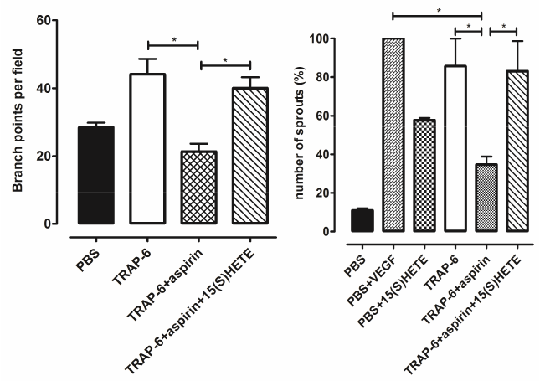Print version
Search Pub Med
Identification of 15(S)-HETE as a major aspirin-sensitive and pro-angiogenic product of platelets Background: In platelets arachidonic acid (AA) is released from the membrane phospholipids of cells through the activity of cytosolic phospholipase A2 α (cPLA2 α) and is then metabolised through cyclooxygenase-1 (COX-1) leading to the production of high concentrations of thromboxane A2 (TXA2), a potent pro-thrombotic hormone. Aspirin by inhibiting COX-1 (1) reduces the levels of TXA2, which accounts for its therapeutic use for the secondary prevention of vascular events. Epidemiological and observational analyses demonstrate that aspirin has benefits beyond inhibition of acute thrombosis and notably is associated with reduction in risk for cancer (e.g. colorectal cancer) (2). This is consistent with aspirin having anti-angiogenic properties. Within this study we determined that, in addition to TXA2, 15- hydroxyeicosatetraeinoic acid (15(S)-HETE) is an important COX-1 product released by activated platelets and have investigated its role in angiogenesis (3). Methods: Blood collected into lepirudin (250µg/ml) by venepuncture from healthy volunteers (n=4) was incubated with aspirin (100µM) for 30min at 37°C either intact or following preparation into platelet rich plasma (PRP) prior to stimulation with TRAP-6 (30µM) or vehicle, in a platelet aggregometer with stirring (1200rpm; 37°C). Plasmas were then separated by centrifugation (12000rpm) for 1min at 4°C. The levels of TXB2 (as a marker of TXA2) and 15-HETE were determined by LC-MS/MS and those of the 15(S)-HETE stereoisomer by EIA assay. The role 15(S)-HETE (1µM) played on angiogenic processes was investigated by assessing tube formation of HMEC-1 cells and formation of sprouts from rat aortas incubated with plasmas obtained from TRAP-6-stimulated platelets which had been treated with aspirin or vehicle. Results : Stimulation of blood or PRP with TRAP-6 caused large, >100 times, increases in the levels of both TXA2 and 15-HETE, which were strongly inhibited by aspirin (Mean±SEM; ANOVA with Dunnett’s test vs vehicle) (Table 1). Treatment of platelets with aspirin strongly reduced the angiogenic effects of platelet releasates in both the endothelial tube formation and rat aorta sprouting models. Addition of exogenous 15(S)-HETE, at the concentration identified in platelet releasates by LC-MS/MS, fully restored both angiogenic responses (Figure 1).
Figure 1. Effect of 15(S)-HETE on formation of a) tubes from HMEC-1 and b) rat aortic sprouts (*P<0.05)
Conclusions: Our results provide an explanation for the anti-angiogenic properties of aspirin and are consistent with aspirin’s beneficial effects in certain types of cancer. We have identified 15(S)-HETE as a major platelet COX-1 product. 15(S)-HETE, in association with other growth factors released by activated platelets, produces pro-angiogenic effects and thus represents a potential target for the development of novel anti-angiogenic therapeutics. (1) Vane, J. R., Thromb Res, 110(5-6): 255-258, 2003. (2) Rothwell, P. M., Lancet, 379(9826): 1591-1601, 2012. (3) Soumya SJ, Inflamm Res., 61:707-718, 2012.
|
|||||||||||||||||||||||||||||||


